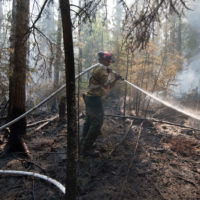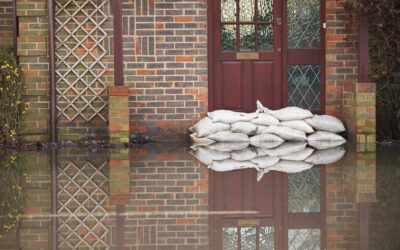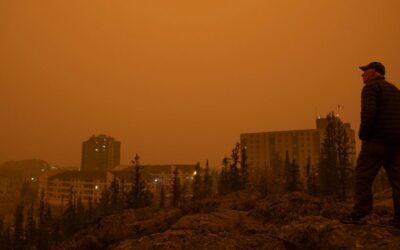Canada experienced its worst wildfire season in recorded history in 2023, with a staggering 19 million hectares burned, more than six times the historical average. Millions of people were exposed to wildfire smoke, thousands of residents were displaced, hundreds lost their homes across the country, and it may take years for wildlife and ecosystems to recover.
The burn doesn’t stop there—wildfires also harmed the economy. Though the full extent of the damage is yet to be assessed, it’s already clear that the unprecedented wildfires this year had significant impacts on the forest industry, which constitutes 1.7 per cent of Canada’s GDP and directly employs more than 200,000 people, especially in rural and remote communities.
As climate change intensifies, more fire is inevitable in the near-term, unless further actions are taken. To reduce future impacts, governments and industry need to consider ways to immediately scale up solutions to increase the resilience of Canada’s forests and forest sector by reducing the risk of widespread wildfires in the future.
Severe wildfire seasons impact livelihoods and Canada’s ability to supply forest products
There are a variety of ways wildfires impact the forest sector. The most visible is that they disrupt forestry operations and reduce the amount of timber supply available, hurting workers and forest-dependent economies in the process. Resolute Forest Products, for example, temporarily closed sawmills this summer after devastating fires tore through Quebec forests. During the 2017 wildfires in B.C., up to 40 forestry companies shut down.
Sawmill closures can set back the forest economy for months. In June and July 2023, lumber production in Canada was 20 per cent lower than the previous five-year average during the same months.
Lower timber supply can lead to a temporary increase in lumber prices, impacting homebuilding and housing affordability. June and July 2023 saw the price of lumber futures rise nearly 20 per cent as wildfires burned across the country, eventually settling back down in August.
Sawmills are just one part of Canada’s larger forest-product sector. When they close, pulp and paper mills also feel the knock-on effects, given that they rely on residual chips and bark to feed their operations. And vice versa—sawmills benefit from the sale of this residual fibre to pulp and paper mills.
Wildfires can also create supply chain challenges and transportation backlogs for forest products, stalling trade. These disruptions result in revenue losses for companies and in some cases lost income for forestry workers. Canfor, for example, reported losing $44 million in the second quarter of 2023, in part due to wildfires.
Beyond immediate supply shortages, wildfires threaten Canada’s timber supply in the medium-term. While some timber can be salvaged after wildfires, previous wildfire seasons have led to lower-quality and less timber available to harvest in some areas.
Climate change means the forest sector needs to adapt to a future of fire
While forest fires are naturally occurring disturbances that contribute to the health and renewal of many forest ecosystems, hotter and drier conditions fueled by climate change will make wildfires more frequent, more severe, and more difficult to manage.
The broader direct and indirect impacts of wildfires on the forest industry will likely worsen. Modelling from the Canadian Climate Institute shows that without further action, the impacts of climate change on forestry, including wildfires interacting with pests and other disturbances, will result in $4 billion in export revenue losses and 32,000 fewer jobs by the end of the century.
These are sizable numbers that threaten further economic hardship on forest-dependent communities, if we don’t implement further measures.
What can be done?
Governments, the forest industry, Indigenous knowledge holders and practitioners face mounting pressure to implement and scale-up solutions to prevent and adapt to the growing impacts of wildfires. There are no quick fixes. The increased role of Canada’s forest sector to address the risk of catastrophic wildfires will require coordinated and whole-of-society actions.
Reducing carbon emissions is crucial to avoid further warming and reduce extreme weather events; at the same time, adapting to a future with more fire is now a necessity.
For governments, communities, and forestry businesses there is a pressing need to assess the current and future risk levels from wildfires on the workforce and infrastructure, and to continue to invest in wildfire emergency preparedness and response.
Governments should better integrate climate adaptation into forest management. For example, modifying reforestation requirements and guidelines to plant a more diverse mix of species – including those with fire-resistant traits – and moving some tree populations to more climatically suitable areas can reduce wildfire risk. Governments should also incentivize more active forms of forest management—such as tree thinning, deadwood removal, and re-introducing cultural burning practices led by Indigenous communities—which help reduce fuels available to burn and prevent wildfire propagation.
The forest industry can be more involved in supporting the implementation of these climate-adaptive forest management practices. Doing so will not only help lessen the economic impact of wildfires on the forest industry, but can protect communities in wildfire-prone areas, and build more resilience in Canada’s forests.
There is also a potential greater role for bioenergy in Canada. The forest products industry can continue to innovate and use emerging technology to convert residual forest material to usable energy, most often in the form of biopellets or wood chips for industrial heat or electricity. Forest harvest residues (e.g. tree tops and limbs) can be used as bioenergy, and at the same time, removing these sources of fuel can reduce the risk of wildfire in fire-prone landscapes.
The wildfire season in 2023 highlighted the urgent need for resilience-building within Canada’s forest sector, one of the nation’s largest employers. As the impacts of climate change continue to intensify, proactive actions from governments and industry players are crucial to ensure Canada’s forests and the livelihoods they sustain can thrive in a future fraught with fire.







